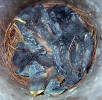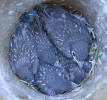FROM EGG TO EMPTY NEST
These photos of Eastern Bluebird nestlings were taken in a nestbox in my backyard in July 2005. Below you will see photos of the various stages: Adult, Egg, Hatchling, Nestling, Fledgling, and Juvenile.
The young became so accustomed to monitoring that they did not get agitated. I continued to actively monitor after Day 13 out of concern for a runt in the nest. When I took the Gilbertson box down (which is open at the top), I stuffed a sock/put a piece of cardboard over the hole to prevent premature fledging, but no attempt was made. I did not handle the nestlings.
These photos might help you figure out the age of your nestlings. For different photos of developing nestlings, see:
- NABS Fact Sheet EABL Nesting Growth Chart that you can take in the field with you.
- Eastern Bluebird Daily Growth Series by Glenn Williams (TX Bluebird Society)
- Age Picture Book by Pam Ford (MD Bluebird Society)
- The Bluebird Monitor’s Guide to Bluebirds and Other Small Cavity Nesters photos by Malinda Matsuko, pages 32-40.
- Also see nesting timetable and All About Eastern Bluebird Biology.
DAY |
Click nest pix to enlarge (links not working!) |
then close the new window to return to this page |
|
|
The male bluebird scouts out nest site locations in February and March. It is the male that sings. Photo by Wendell Long. |
|
|
|
The female is more gray, and has a white eye ring. She makes the final choice for a nest site.Nest building usually takes 2-6 days. During colder weather, it can take longer. Photo by Wendell Long. |
|
|
|
A Gilbertson box was chosen this year for both the first and second broods. (I don’t usually get bluebirds in this style box, but it is good for photography as it opens from the top.) This box sports a sparrow spooker that was installed after the 1st egg had been laid to prevent House Sparrow attacks.Bluebirds only lay 1 egg per day. This particular nest is made of pine needles. |
|
|
|
Three eggs laid so far. Bluebirds usually lay 4-5 – sometimes 6 or 7. Second and third broods tend to have fewer eggs. This is a second brood for this pair.Occasionally an Eastern Bluebird will add feathers to a nest. |
|
|
|
Incubation does not begin until all eggs have been laid, so they will hatch at the same time. Since it was hot, I rarely saw this female on the nest. Incubation typically lasts 12-14 days. The female may wait about a week to start incubating the clutch if weather is still cold. Keith Kridler notes that bluebird eggs are rather dull when first laid, but get slick and shiny when they are close to hatching (about 10 days) after being sat on, turned regularly by the mother, and rubbing against each other. |
|
0 |
|
The embryos use their “egg tooth” to peck their way through the shell. This hard tip on the beak eventually falls off. Eastern Bluebirds take 1-6 hours to pip through the shell (it can take an Albatross 6 days!) It can take 24-48 (rarely 72) hours for all eggs to hatch. NEVER remove unhatched eggs until 4 days have passed since the first one hatched.Note: some people count this as Day 1. See another close up of a newborn. |
0 |
|
Notice the wet gray down on the recently hatched nestling. Three down, two to go. The hatchlings have bright coral-pink skin. Eyes are sealed shut. The abdomen of the bird at the top of the photo is swollen because prior to hatching, the chick swallows most of the liquid in the egg, and pulls the membrane yolk into its abdomen. |
0 |
|
They look like hairy shrimp at this stage, with sparse, wispy tufts of down on their heads and backs. The female will brood them to keep them warm. One egg left. There are no eggshells in the nest, so they were eaten (recycling the calcium)/removed by the parents. |
0 |
|
Hatching often occurs in early morning, Despite floppy necks, gaping is automatic. The nestlings have powerful “hatching muscles” on the back of their head and necks that probably help. At this stage, babies are quite fragile and should not be handled. If you want a count, whistle and they should gape. |
0 |
|
At the end of Day 0, one egg has still not hatched. The babies heads look huge. Their wings are nubs, and their legs are weak and spindly. Their eyes are closed.On average, 10-15% of bluebird nests have unhatched eggs. |
1 |
|
By Day 1, all eggs have hatched. Parents (both male and female) feed the nestlings at least twice an hour.Since their digestive tracts are not developed yet, they do not fully digest food, so parents may eat the droppings. Later they will remove the fecal sacs (60 to 70 bundles a day!) |
1 |
|
I offer mealworms to help the parents feed the hungry nestlings. I’m raising my own, since they get expensive. |
2 |
|
Day 2. Contour feathers start to develop. |
2 |
|
Soft gray down is now along the edges of wings, the head and spine. The skin beneath looks blue-black as feathers begin to develop beneath it. |
3 |
|
Day 3. At this age the babies weigh about 1/3 of an ounce (10 grams). |
3 |
|
|
3 |
|
One of the babies (the last to hatch probably) is clearly smaller than her nest mates. |
4 |
|
Feather sheaths begin to emerge on wings. Wings are darker. Eyes are still closed.If any eggs haven’t hatched by the 4th-6th day after the others, it’s okay to remove them. Unhatched eggs can explode into a stinky mess and cause other problems. |
5 |
|
Nestlings can’t regulate their body temperature for the first six days. Cheeping is louder. Eyes may begin to open as slits. |
6 |
|
|
7 |
|
Eyes usually open on Day 5-8. First feathers burst from tip of sheaths. The female no longer broods, because the young can maintain their body temperature by Day 7-9. |
8 |
|
Eyes open on Day 8-11, and feathers continue to come out of sheaths. By now they should weigh a little less than an ounce (19-25 grams). Feeding visits are about every 5 minutes.Nestlings may cease gaping when nest is monitored. Instead they hunker down, eyes closed. The runt still gapes. |
9 |
|
I am concerned about the smallest baby. She seems far behind the others developmentally – notice the difference in feather cover. By this age, nestlings may show fear if handled, and can crawl. |
10 |
|
The runt continues to gape. The hungriest baby cheeps the loudest and gapes the most to stimulate feeding by the parents. |
11 |
|
Feather sheaths start to disintegrate (leaving a white dust behind) and wing feathers begin to emerge. Nestcams indicate nestlings start to stand up at this age.By Day 11 the nestlings start to preen, pulling at the sheaths of emerging feathers. They may stretch and hop a little to strengthen muscles. |
12 |
|
Nestlings are almost completely feathered. White eye rings may be visible.I did a nest change on day 12 as I saw blow fly larvae, and was concerned about them. I wouldn’t recommend it after this date as babies might prematurely fledge. |
13 |
|
By Day 13-14, males have bright blue feathers. (There are usually more females than males in a brood.) Stop active monitoring now to avoid premature fledging, unless you suspect a problem. You can still check the box from a distance to verify that the parents are feeding the young. One way to tell they are at this age is that the parents tend to only dip their heads into the box to feed (but may still enter to remove fecal sacs. Females have white edging on outer tail feathers. This nest holds 4 females and one male.By this stage, babies are strong enough to cling to the entrance of the nestbox to look out. They have a narrow ring of white feathers around each eye, and their breasts are speckled with gray. |
14 |
|
No unfeathered areas are visible. At this age, nestlings are capable for short, weak flight. The runt is still much smaller. I decide not to interfere, as the parents continue to care for all the young, and the runt continues to develop. Perhaps the mealworms will help it survive. |
15 |
|
Notice the cobalt blue feathers of the male. Nestlings exercise more, and may stand on the edge of the nest and look out of the nest cavity.When I took these photos (since they were after Day 13) I blocked the entrance hole and moved quickly and quietly. Premature fledging is less likely in a top opening box. |
16 |
|
Bluebirds generally fledge 16-21 days after hatching, typically 17-18. Development depends on food availability. The parents often get more defensive around the box at this time, and may divebomb passersby. Nestlings are able to hop. |
17 |
|
At this point, the Gilbertson box, which is 4″ in diameter, is quite crowded.Western and Mountain Bluebirds typically stay in the nest longer than Eastern Bluebirds – 22-23 days, depending on the weather. |
18 |
|
All 5 babies are still in the nest, eyes open, fully feathered. The runt is on the bottom of the pig pile. |
19 |
|
By early morning, four have fledged. At fledging, the babies weigh slightly more than their parents.The runty girl has not fledged. The parents continue feeding her mealworms. As I approach the box I hear her calling to them. |
20 |
|
The runtess is still in the nest! I probably should check to make sure that her feet are not tangled in anything, and that her wings are okay. There is some fecal material in the nest, as the parents have probably stopped removing it. |
20 |
|
She finally fledges by 1:00 p.m. that day – PHEW! I have heard reports of the last one leaving a full three days after the other (when the first ones fledged around day 16.)Empty nest syndrome begins. The nest is typically flattened and soiled. A dead mealworm lies in the nest.Young stay in cover for several weeks. Parents will continue to feed them until they are about 30 days old. |
More Information and References:
- NABS Fact Sheet EABL Nesting Growth Chart that you can take in the field with you.
- Bluebirds Forever, Connie Toops
- The Bluebird Monitor’s Guide to Bluebirds and Other Small Cavity Nesters, Cynthia Berger, Keith Kridler, Jack Griggs.
- Enjoying Bluebirds More: A Special Publication from Bird Watcher’s Digest, Julie Zickefoose
- Gowaty, Patricia Adair and Jonathan H. Plissner. 1998. Eastern Bluebird (Sialia sialis), The Birds of North America Online (A. Poole, Ed.). Ithaca: Cornell Lab of Ornithology; Retrieved from the Birds of North America Online: http:// bna.birds.cornell.edu/bna/species/381 doi:10.2173/bna.381
- Bluebird nesting biology
- When will the first egg be laid?
- How many eggs will a female lay?
- How many broods will a bluebird have?
Helping bluebirds is a deeply satisfying hobby, and a unique adventure in conservation.
– Steve Grooms and Dick Peterson, Bluebirds, 1991



































